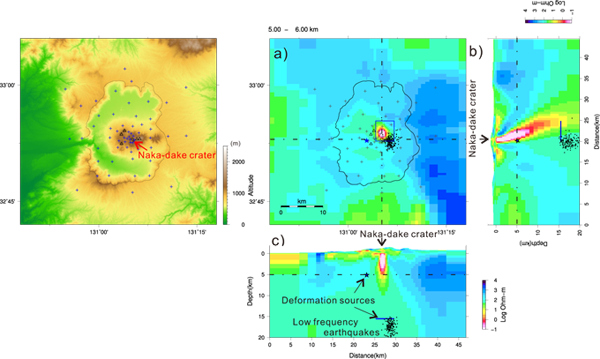 Magmatic Activity Research Group
Magmatic Activity Research Group
Magmatic activity research group is conducting researches to model various volcanic phenomena for forecasting eruption and evolution of volcanic activity in cooperation with the volcanic activity research group.
For volcanic hazard mitigation, it is important to predict the eruption style and its evolution. Recent development of the monitoring tools enables detection of precursory phenomena, however it is still quite difficult to predict eruption style and its evolution. Therefore, we need to know more examples of past eruptive activities to extract common features of eruption style and its evolution and to understand their controlling process and mechanisms. We, magmatic activity research group conduct researches to model volcanic phenomena with various approaches including geochemical and petrological analyses of eruption products, observation of volcanic gas, electro-magnetic phenomena and ground deformation, various laboratory and numerical experiments, in order to develop methods to predict evolution of eruptive activities.
To group homepage ![]()
![]() https://unit.aist.go.jp/ievg/magma-rg1/index.html (in Japanese)
https://unit.aist.go.jp/ievg/magma-rg1/index.html (in Japanese)

A resistivity structure was obtained from three-dimensional inversion of magnetotelluric data in and around Aso caldera (Crosses in the left figure are observation stations); a) horizontal section at depths of 5-6km, b) and c) east-west and north-south vertical sections through Naka-dake crater, respectively. Conspicuous low resistive body (< 1 Ω•m) northward dipping from Naka-dake crater, reveals a magma path associated with the recent active eruptions.
Member
- Akihiko Tomiya (Leader, Group)
- Ryunosuke Kazahaya (Senior Researcher)
- Takayuki Nakatani (Senior Researcher)
- Naoki Araya (Senior Researcher)
- Kurumi Iwahashi (Researcher)
- Tatsuya Konoo (Researcher)
- Marceau Gresse (Researcher) (concurrent)
- Nobuo Matsushima (Technical Staff)
I am interested in the mechanism of volcanic eruptions, in particular the beginning and sequence. I am investigating pre-eruptive magmatic processes in magma chambers and volcanic conduits, using petrographical methods, such as: analyzing zoning profiles of phenocrysts (e.g., plagioclase and magnetite) to reveal changes in temperature and pressure or injection of mafic magma; high-pressure melting experiments for estimating pre-eruptive magmatic conditions or magma ascending processes.
My main interests are modeling of eruptive activities and/or movement of magma at a depth within a volcano by way of volcanic gases study. Degassing process of magma is crucial to get insights of volcanic activities. Recently I've focused on a linkage between volcanic gas and geophysical data in order to comprehend volcanic phenomena.
I utilize high-temperature and high-pressure experimental techniques to investigate the migration and storage of magma and aqueous fluid in the Earth’s interior. Especially, I'm interested in the hydration and dehydration reactions of mantle and crustal rocks in subduction zones and the storage depth of magmas beneath arc volcanoes.
I conduct geothermal and electromagnetic observations at active volcanoes. Main targets are surface temperature distribution, heat discharge rate, self-potential distribution and resistivity structure. These results are used as boundary conditions for numerical simulations, and modeling of magma-hydrothermal systems at various volcanoes is developed.

